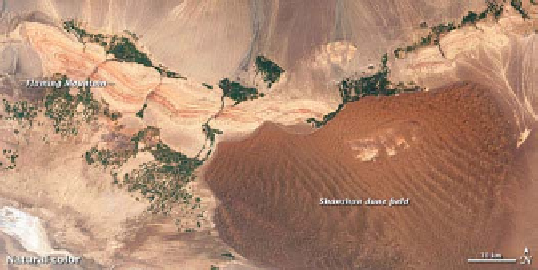Geoscience Reference
In-Depth Information
DISCOVER…
WHAT IS THE LAND SKIN TEMPERATURE?
Have you ever heard the old saying that
it's 100 degrees in
the shade
? This phrase is intended to reflect the idea that
it is really hot outside, so hot that it is even uncomfortable
underneath big trees that block the Sun. The old saying
makes sense because everyone understands on some level
that it is usually hotter in the direct Sun than it is elsewhere.
This relationship exists because your skin is heated by both
the radiant heat of the Sun and the warm air surrounding
you. For similar reasons, official air temperatures are always
taken in indirect light because structures can absorb radiant
energy, which can affect readings.
Scientists have applied the understanding of tempera-
ture variability between sunny and shady areas to a concept
called land skin temperature, which reflects the pure heat-
ing of the ground by solar radiation, the atmosphere, and
other heat flows. The concept of land skin temperature is
based on the fact that the many different kinds of surfaces
within an area, such as those that are vegetated or consist
of exposed rock or sand, have different temperatures based
on factors such as albedo, dryness of the soil, character
of sediment, and degree of shade. NASA scientists mea-
sure the land skin temperature with the Moderate Resolution
Imaging Spectroradiometer (MODIS) satellite. As you can
see in the accompanying satellite image of the Taklamakan
Desert in China, the surface skin temperature can vary con-
siderably over a small geographical area, ranging from 30
o
C
(86
o
F) in the crop areas to over 50
o
C (122
o
F) in the nearby
dune field. This variation occurs because the dark surface
of the dune field absorbs more radiation than elsewhere.
Why does skin temperature matter to you? Remember that
if it really is 100 degrees in the shade where you live on a
summer day, it must be
really
hot in the direct Sun.
MODIS image of the Taklamakan Desert in China. Compare
the natural color image at the top with the skin temperature
image at the bottom. Can you see the geographical variability in
temperature and why it occurs?
Surface temperatures can vary dramatically even in conventional
suburban landscapes due to degree of direct sunlight, shade, and
character of the surface.







